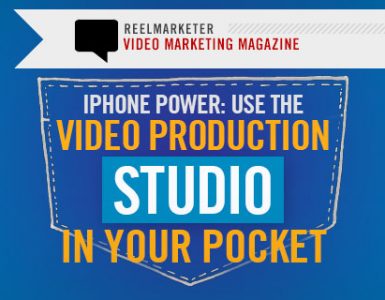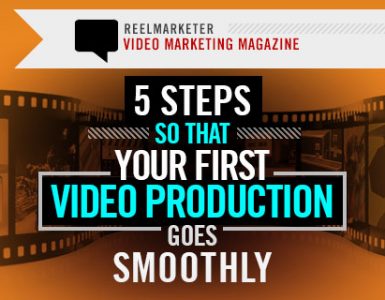Week two of Ellen Friedland's series ‘Tips for Corporate Video Production' hosted by New York video producer, Ellen Friedland! Once a week, a new set of tips will be published on Reel Designer with a relevant tip to help you save time or increase production value on your next shoot!
Week 2: Making the Most of a Customer Event: Creating Marketing Web Videos on Various Topics
By Ellen Friedland
My last entry talked about recording an annual customer or membership event in a single day to produce multiple short video web clips highlighting a client’s strengths from the viewpoints of its customers or members who are the interviewees in the video. The camera crew’s key focus at these events should be to capture as many interviews with different customers or members as possible, with a secondary emphasis on collecting some b-roll shots.
 The video recorded at these events can also have uses beyond creating a number of finished videos featuring simple, single-speaker sound bites. Another way of organizing the material filmed is to group the voluminous number of sound bites by topic, then produce separate videos around each topic. These might include “About Us,” “Core Values,” or other concepts of importance to the particular organization. In comparison to the large collection of ultra-short videos previously discussed, this variety would run about two to three minutes in length and would feature several speakers, each addressing different aspects of the topic of the video.
The video recorded at these events can also have uses beyond creating a number of finished videos featuring simple, single-speaker sound bites. Another way of organizing the material filmed is to group the voluminous number of sound bites by topic, then produce separate videos around each topic. These might include “About Us,” “Core Values,” or other concepts of importance to the particular organization. In comparison to the large collection of ultra-short videos previously discussed, this variety would run about two to three minutes in length and would feature several speakers, each addressing different aspects of the topic of the video.
A transcript encompassing all of the interviews should be produced subsequent to the event in order to provide a blueprint for scriptwriting. (Sharing a copy of the transcript with the client is an added benefit; quotes can be culled from within those reams of pages to be used for online newsletters, written testimonials, or other purposes.)
It is the job of the writer to read through the transcript to identify key themes, rearrange the material – with time codes – by topic, then use that as a basis to produce pieces on each subject with organized, coherent, sequential flows, utilizing sound bites from different individuals and adding contextual and transition-purposed devices such as textual graphics or, if desired, a narrator’s role.
[embedit snippet=”ad2″]As compared to the stand-alone sound bite videos which, in their succinctness, leave little time for b-roll other than a few quick shots to cover necessary cuts, the length of concept videos call out for visuals to break up the monotony of talking heads – even those whose words are filled with content. A challenge is posed by a client – the organizer of the customer or membership event – who prefers to pay solely for a one-camera shoot, limiting b-roll opportunities since the camera time will mostly be spent capturing interviews.The director of photography should try to break off at any opportunity to capture at least a few visuals, particularly those most relevant to the sound bites that interviewees are expressing.

Other examples of b-roll in concept videos molded out of the single-day of material recorded might include the use of slides from power point presentations to affirm points that speakers are making, the creation of full-screen graphics underscoring relevant information, obtaining good resolution photos or videos from customers or members that are appropriate to the topics, and purchasing relevant, quality-grade stock footage or still images.
[embedit snippet=”googleplus”]In short, a single day of videotaping during a customer or membership event, in addition to yielding numerous single-speaker video web clips, can also be the basis for producing several videos on topics of importance to the organization since so many potential interviewees will be present. With field production generally charged by the day, planning this out in advance can yield tremendous benefits at a very reasonable cost.To ensure success in producing several concept videos from material recorded at one event, some steps that marketers should take when organizing sizeable customer or membership events are:
- Have a video production crew present and set up in a quiet room near the event space to interview a number of pre-designated people individually
- Do homework in advance to become familiar with the topics that will be the subjects of the various videos, and prepare relevant, in-depth questions
- Try to leave some time for the crew to capture b-roll of the meeting, breakout sessions, networking opportunities, etc.
- Request copies of power point presentations, professional photos and videos, and marketing materials that can be made into graphics, all of which can be woven into the video, and
- Post the final approved versions on the client’s social media sites and website
Update: My next article is now and ready to read – click here!






HI Ellen thanks for writing your series! Ive been asked to do some face-and-voice videos for my company because i have some familiarity with tech. And honestly im interested and up to the challenge of learning how to do it so i can be of even more use. And videos look fun.
I have done an interview in the past but it was difficult for me tease out a usable narrative out of the person(s) being interviewed, Very stilted, and often I received a bit of flak from them because, from i gather, they were nervous and my inexperience showed.
How do i create a more hospital environment to get the performance i need to make a (half) decent video? How do I get cooperation? I’m a pretty easy going guy, maybe a little too easy going,
Hi Timothy,
Sorry about my delay in responding — I hadn’t seen your message earlier.
You ask a very important question. It is crucial that the producer asking the questions (you!) is listening to the responses through the ears of how they may later be cut at the same time as you are tuned into the substance of the comments to ensure you are getting the information you need. If you hear some speech impediments in answers (eg, a clearing of the throat, a cough mid-sentence, or an “um” between every one to two words), you need to stop the interviewee and ask him/her to begin the thought again — however many times that takes, unless you see that the repeated request is met with agitation that spirals downward.
It is also essential that you do your best to get the interviewee to relax. There are no hard and fast rules regarding how to do that; each person responds differently, and finding that way in, particularly for the recalcitrant person, is part of the art of successful interviewing. Try to understand what specifically is adding to the anxiety, then work around it as best as you can. For instance, you might learn that a person is sensitive to bright lights, in which case you can adjust them, or someone else just started working at a place of business a week before and does not yet feel confident answering anything more than superficial inquiries, for which you should adjust your list of questions.
Being successful at interviewing involves a combination of psychological, journalistic and technical skills, all of which improve with experience and interest in the subject matter!